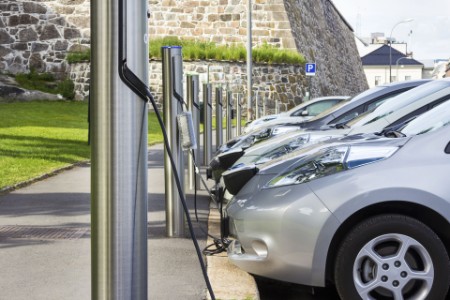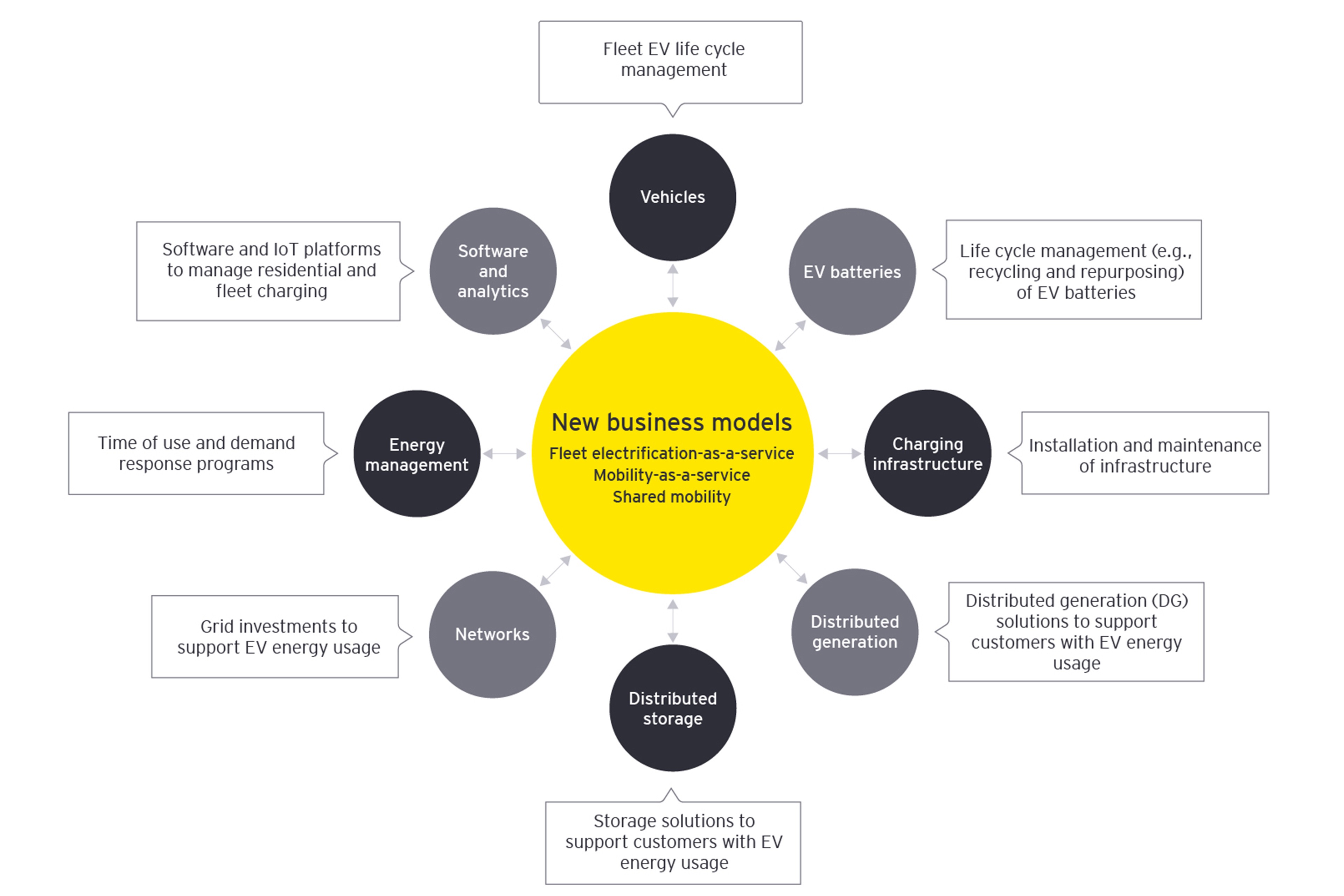US utilities have a significant role to play in improving the integration of EVs with the electric grid and providing the required infrastructure to help drive the growth of this market.
Utilities could also support the evolution and deployment of software required to modulate charging rates or shift charging events to provide grid services. However, we note that developing the infrastructure and smart grid is an ambitious goal, especially as market demand and return on investment expectations are not well understood.
To compete, utilities can explore partnerships with a variety of ecosystem players, such as oil and gas companies, technology providers, charging location owners, infrastructure operators, service providers, vehicle users, mobility providers, financial services and leasing companies. We have grouped potential opportunities into four main categories:
1. EV batteries and vehicles
In the short term, corporates wanting to explore how to procure an EV fleet may find it more attractive to lease instead of purchase, while the economics grow more favorable. A few EV and original equipment manufacturers are also offering the option to purchase a vehicle and separately lease the battery — which typically needs to be replaced after 7 to 10 years — as a new business model. These leasing agreements are generally packaged with a warranty and battery replacement contracts, to make the most expensive component in an EV today cheaper to afford up front. Additionally, third-party players have started to develop battery-as-a-service business models that are geared toward bringing more moderately priced battery replacement solutions to the market.
There are also opportunities in repurposing and recycling EV batteries. After a typical EV battery is removed, 50% to 70% of the power capacity is retained, which could be repurposed for tasks such as power backup, renewable energy storage and grid stabilization. After these second-life actions, recycling is the final stage. By 2025, about 75% of EV batteries will be reused and recycled to harvest raw material, with commercial vehicles presenting the largest opportunity.2
2. Charging stations
Although many infrastructure operators exist in the US, a standard business model has yet to be established for EV charging stations. Overall, the EV supply equipment (EVSE) vendor landscape is in flux, with numerous acquisitions, cross-industry investments and technological advancements in progress. Utilities, oil majors, network operators, software developers, etc., are becoming active in the market, to gain early-mover advantage.
Requirements for commercial and industrial charging infrastructure vary greatly, based on region and utility market structure. This presents an opportunity for utilities to help fleet operators evaluate and develop charging station strategies. Installation services will serve as the primary revenue driver.
Many utilities offer special tariffs or plans for the retail of electricity for EV charging. Operators of charging networks typically provide charging station hardware, cloud-based software services, technical support and other EVSE management services, such as payment processing. Utilities and EVSE operators should focus on smart charging capabilities and their evolution, such as vehicle-to-grid charging.
3. Distributed energy sources
Fleet operators could benefit from utilizing distributed energy resource (DER) technologies, including solar modules and inverters, fuel cells and energy storage, as a power source to charge their vehicles. While DERs make up a small portion of the overall US power supply, continued decline in installation and operational costs will make these business cases more viable. The high costs of DER technologies are an obvious deterrent for fleet charging, but costs are coming down fast and, compared with centralized charging, they offer greater scalability, reliability and flexibility.
These services are in a nascent stage, but a forward-thinking company can build capabilities to provide a one-stop experience for fleet operators looking to use DG sets as a power source. Opportunities exist across engineering, procuring and constructing solutions for installing DER to support fleet electrification. As the market matures, competition from other energy services companies will increase.
4. Software and analytics
Fleet operators will increasingly look for software capabilities that will enable them to deploy and manage their own network of smart EV charging stations. Some of the key capabilities include real-time monitoring, fault notification, electric pricing management, prioritized charging, customer reporting and mobile app access. Furthermore, additional benchmarking capabilities, such as vehicle utilization (on and off hours), driver behavior and cost metrics, will create a more user-friendly experience for fleet operators.
These opportunities highlight just how dynamic the EV environment is. For example, the trend of decoupling the ownership of the EV and the battery will begin to accelerate, generating more flexible leasing deals and blockchain platforms. And smart contracting can be deployed to manage the complicated ownership and transaction structures. By providing the underlying infrastructure and filling other needs across the value chain, forward-thinking US utilities can position themselves for growth, capitalizing on the emerging opportunities as more fleet operators explore electrification.
How EY can help
EY UtilityWave
EY UtilityWave is an award-winning, business-led data platform that helps companies transform how they manage, integrate and use data from enterprise systems, IoT devices and other sources to improve performance. Powered by Microsoft technology, EY UtilityWave supports clients in accelerating the digitization of network assets and operations, delivering new energy services and reshaping for the future.
Read moreSummary
EVs are expected to achieve cost parity with gasoline-powered vehicles in about five to six years in most US regions and eventually overtake the internal combustion engine market. Utilities have a huge role to play in enabling this clean energy transition and, if they act decisively, can capture a first-mover advantage to help fleet operators in particular go green. Utilities will need to support the deployment of EV charging infrastructure, provide incentives to encourage investments by commercial operators, and upgrade the grid to handle additional electric load.


